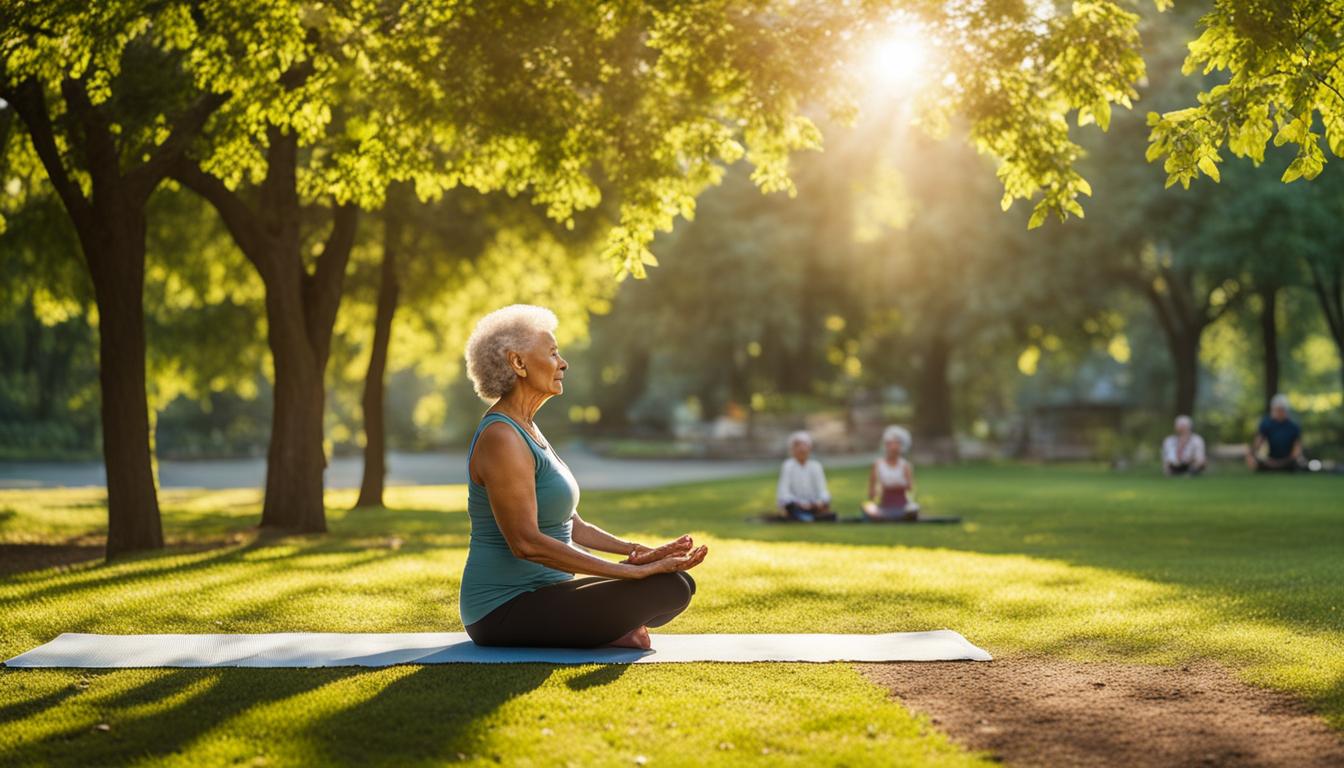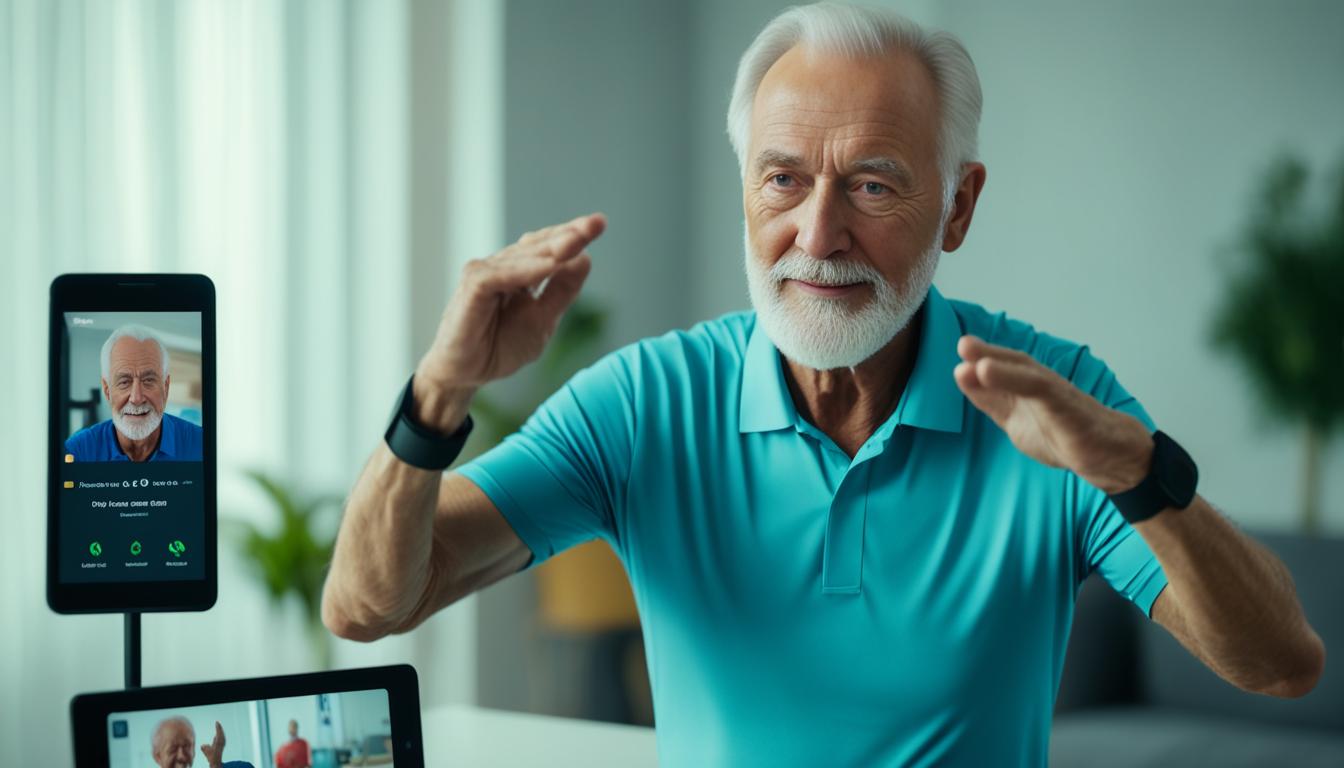Engaging in regular exercise and fitness routines can have significant benefits for seniors. These routines, designed specifically for older adults, take into consideration their unique physical needs and abilities. Senior fitness programs can improve strength, cardiovascular health, balance, flexibility, and overall well-being, enabling seniors to optimize their health and enhance their vitality.
Key Takeaways:
- Senior fitness routines are tailored to the needs of older adults.
- Regular exercise can improve strength, cardiovascular health, balance, flexibility, and overall well-being.
- Engaging in senior fitness programs can optimize senior health and enhance vitality.
- Consulting with healthcare professionals or certified personal trainers is important to create safe and effective workout plans.
- Incorporating senior fitness routines into daily life can lead to a higher quality of life for older adults.
The Importance of Senior Fitness
Research has shown that regular physical activity and exercise are essential for maintaining good health and well-being in older adults. Engaging in senior fitness routines can help prevent and manage chronic conditions, increase functional ability, improve mobility and flexibility, and promote healthy aging.
Physical activity has been associated with a reduced risk of various health issues, including heart disease, stroke, diabetes, obesity, and cognitive decline. Therefore, incorporating senior fitness routines into daily life is crucial for older adults to optimize their health and overall quality of life.
“Regular physical activity and exercise are essential for maintaining good health and well-being in older adults.”
By engaging in senior fitness routines, you can improve your strength, cardiovascular health, balance, flexibility, and cognitive function. These routines are specifically designed to address the unique physical needs and abilities of older adults.
By incorporating regular exercise into your daily life, you can experience numerous benefits, including:
- Preventing and managing chronic conditions
- Increasing functional ability
- Improving mobility and flexibility
- Enhancing cognitive function
- Promoting healthy aging
Make senior fitness a priority and take control of your health and well-being. Consult with a healthcare professional or certified personal trainer to create a safe and effective workout plan tailored to your needs and abilities. With consistency and dedication, you can optimize your health and enjoy a higher quality of life through senior fitness routines.
Types of Senior Fitness Routines
There are several types of senior fitness routines that are beneficial for older adults. Incorporating a combination of these routines into your fitness regimen can help you maintain a healthy and active lifestyle.
Strength Training Exercises: These exercises focus on improving muscle strength and bone density. By using resistance, such as weights or resistance bands, you can target specific muscle groups and increase overall strength. This type of training is important for reducing the risk of falls and fractures.
Cardio Workouts: Engaging in cardio exercises helps improve cardiovascular health and endurance. Walking, swimming, cycling, or even dancing are great examples of cardio workouts that seniors can incorporate into their routine. These activities get your heart rate up and increase oxygen flow throughout the body.
Balance Exercises: Balance exercises are essential for maintaining stability and preventing falls. Simple activities like standing on one leg or practicing yoga can help improve balance and coordination. These exercises strengthen the core and leg muscles, which are crucial for maintaining stability.
Flexibility Routines: Flexibility exercises focus on enhancing joint mobility and range of motion. Stretching exercises, yoga, or tai chi can help improve flexibility and keep the body agile. These routines can also help alleviate muscle stiffness or joint pain.
By incorporating a variety of strength training exercises, cardio workouts, balance exercises, and flexibility routines, you can achieve a well-rounded fitness regimen that addresses multiple aspects of senior fitness.

Creating a Senior Workout Plan
When it comes to senior fitness, creating a personalized workout plan is essential to achieve your health and fitness goals. Whether you want to improve strength, increase cardiovascular endurance, enhance balance, or increase flexibility, a well-thought-out workout plan tailored to your needs will maximize your progress.
To create an effective senior workout plan, it’s important to consider your individual goals, physical abilities, and any existing health conditions. Consulting with a healthcare professional or a certified personal trainer can provide the guidance and expertise needed to ensure a safe and efficient plan.
Your workout plan should include a variety of exercises that target different muscle groups and aspects of fitness. Incorporating exercises that focus on strength training, cardiovascular endurance, balance, and flexibility will provide a well-rounded fitness regimen.
Strength Training: Include exercises that use resistance and target major muscle groups, such as squats, lunges, chest presses, and bicep curls. These exercises help improve muscle strength, increase bone density, and reduce the risk of falls and fractures.
Cardiovascular Endurance: Engage in activities that increase your heart rate and breathing, such as walking, cycling, swimming, or dancing. These exercises improve cardiovascular health, increase stamina, and boost overall endurance levels.
Balance: Incorporate exercises that challenge your balance and stability, such as standing on one leg, heel-to-toe walks, or yoga poses. These exercises help maintain stability, reduce the risk of falls, and improve overall coordination.
Flexibility: Integrate stretching exercises into your routine to enhance joint mobility and increase range of motion. Yoga, tai chi, or simple stretching exercises like shoulder rolls and hamstring stretches can improve flexibility and reduce muscle stiffness.
It’s important to start with low-intensity exercises and gradually increase the intensity and duration as you build strength and endurance. This progressive approach ensures a safe and effective workout plan for seniors.
Remember, it’s essential to listen to your body and take breaks when needed. Rest and recovery are just as important as exercise itself. Make sure to hydrate properly and wear appropriate footwear to prevent injuries.

By following a carefully planned senior workout plan, you can optimize your health and fitness, improve overall well-being, and enjoy an active and vibrant lifestyle as you age.
Tips for Achieving Senior Fitness Goals
Setting realistic and achievable fitness goals is crucial for seniors on their fitness journey. Here are some tips to help you achieve your senior fitness goals:
Find an activity that is enjoyable and suits your individual preferences: Engaging in an exercise or fitness routine that you enjoy will increase your motivation to continue and make it easier to stick with your fitness goals. Whether it’s walking, swimming, dancing, or yoga, find an activity that brings you joy and fits your lifestyle.
Stay consistent with your routine: Consistency is key when it comes to achieving fitness goals. Make exercise a regular part of your daily or weekly schedule, and try to stick to it even when you feel less motivated. Consistency will help you build strength, endurance, and overall fitness.
Listen to your body and take breaks when needed: It’s important to pay attention to your body’s signals. If you feel any pain or discomfort during your workout, take a break or modify the exercise to avoid injury. Rest and recovery are just as important as exercise for your overall health and well-being.
Progressively challenge yourself to improve fitness levels: As your fitness improves, don’t be afraid to challenge yourself. Gradually increase the intensity, duration, or difficulty of your workouts to continue making progress. This could mean adding more weight to your strength training routine, increasing your walking or running distance, or trying new exercises to challenge different muscle groups.
Seek social support or join group exercise classes: Exercising with others can provide motivation, support, and accountability. Consider joining a group exercise class specifically designed for seniors or find a workout buddy who shares similar goals. Surrounding yourself with like-minded individuals can help you stay motivated and committed to your fitness journey.
Prioritize safety: Before starting any exercise routine, remember to warm up your body with a few minutes of light cardio or stretching. Use proper form during exercises to avoid unnecessary strain or injury. Wear appropriate footwear for your chosen activity to provide stability and support. And most importantly, stay hydrated throughout your workout to maintain optimal performance.

Stay motivated and overcome challenges:
“It’s important to remember that progress is not always linear. There may be setbacks or plateaus along the way, but don’t let them discourage you. Stay focused on your goals, celebrate your achievements, and remember that every small step forward is a step closer to better health and fitness.” – Dr. Emily Johnson
The Benefits of Senior Fitness on Overall Health
Engaging in regular senior fitness routines has numerous benefits for overall health and well-being. Physical activity can help maintain a healthy weight, reduce the risk of chronic diseases, improve cardiovascular health, enhance cognitive function, boost mood and mental well-being, increase energy levels, improve sleep quality, and promote a sense of independence and self-confidence.
By prioritizing fitness and incorporating regular exercise into your lifestyle, you can optimize your overall health and enjoy a higher quality of life.

The Role of Technology in Senior Fitness
Technology can play a significant role in improving senior health and fitness. With the advancement of wearable devices like smartwatches and fitness trackers, seniors now have access to a wide range of tools that can help them stay active and motivated.
These wearable devices are equipped with features that monitor activity levels, provide real-time feedback, track progress, and encourage seniors to maintain an active lifestyle. By wearing these devices, seniors can easily keep track of their daily steps, calories burned, and distance covered.

Furthermore, these devices can assist seniors in setting fitness goals and monitoring their heart rate and sleep patterns. This valuable information allows seniors to make informed decisions about their exercise routines and take necessary steps towards achieving optimal health and fitness.
In addition to wearable devices, mobile apps and online platforms have transformed the way seniors engage with fitness programs. These platforms provide access to a variety of senior exercise programs, guided workouts, instructional videos, and personalized fitness plans.
Seniors can now conveniently access these resources from the comfort of their own homes, eliminating the need for gym memberships or in-person classes. This accessibility empowers seniors to take control of their health and fitness on their terms and at their own pace.
“The integration of technology in senior fitness allows for greater convenience and flexibility in maintaining a healthy and active lifestyle. With these tools at their disposal, seniors can easily track their progress, stay motivated, and achieve their fitness goals,” says Dr. Emily Roberts, a leading expert in senior health and fitness.
Stay Active and Connected
Technology not only benefits physical health but also enhances the social aspect of senior fitness. Virtual fitness classes and online communities enable seniors to connect with like-minded individuals and participate in group activities without leaving their homes.
“By leveraging technology, seniors can join online fitness classes, interact with instructors, and even challenge their peers. This sense of community and camaraderie fosters motivation and helps seniors maintain a consistent exercise routine,” adds Dr. Roberts.
Embracing technology in senior fitness provides seniors with the tools and resources to lead an active, healthy lifestyle. By incorporating wearable devices, mobile apps, and online platforms into their fitness routines, seniors can optimize their health, improve their overall well-being, and make fitness a lifelong habit.
Conclusion
Incorporating senior fitness routines into your daily life can have a significant positive impact on your overall health and well-being. By engaging in regular exercise, you can improve your strength, cardiovascular health, balance, flexibility, and cognitive function. These routines, specifically designed for older adults, aim to optimize your health and enhance your vitality in your golden years.
It is important to consult with healthcare professionals or certified personal trainers to create a safe and effective workout plan that suits your individual needs and abilities. They can provide guidance and ensure that you are performing exercises correctly, minimizing the risk of injury. By tailoring your fitness routine to your specific goals and physical condition, you can make the most out of your senior fitness journey.
Consistency, motivation, and a focus on achievable goals are key to success. Set realistic fitness goals that align with your abilities and gradually increase intensity and duration as you progress. Stay committed to your routine, listen to your body, and take breaks when needed. Remember, every small step towards your fitness goals counts and contributes to your overall health.
By prioritizing senior fitness and incorporating regular exercise into your lifestyle, you can optimize your health, enhance your vitality, and enjoy a higher quality of life. So why wait? Start your senior fitness journey today and reap the numerous benefits it has to offer.
FAQ
What are senior fitness routines?
Senior fitness routines are exercise programs designed specifically for older adults to improve their strength, cardiovascular health, balance, and flexibility.
Why is senior fitness important?
Senior fitness is important because it can help prevent and manage chronic conditions, increase functional ability, improve mobility and flexibility, and promote healthy aging.
What types of senior fitness routines are there?
There are several types of senior fitness routines, including strength training exercises, cardio workouts, balance exercises, and flexibility routines.
How can I create a senior workout plan?
To create a senior workout plan, it is important to consider individual goals, physical abilities, and any existing health conditions. Consulting with a healthcare professional or a certified personal trainer can provide guidance and ensure a safe and effective workout plan.
What are some tips for achieving senior fitness goals?
Some tips for achieving senior fitness goals include finding enjoyable activities, staying consistent with the routine, listening to the body, progressively challenging oneself, and seeking social support or joining group exercise classes for motivation and accountability.
What are the benefits of senior fitness on overall health?
Engaging in regular senior fitness routines can have numerous benefits on overall health, including maintaining a healthy weight, reducing the risk of chronic diseases, improving cardiovascular health, enhancing cognitive function, boosting mood and mental well-being, increasing energy levels, improving sleep quality, and promoting a sense of independence and self-confidence.
What role does technology play in senior fitness?
Technology can play an important role in senior fitness by providing wearable devices, such as smartwatches and fitness trackers, to monitor activity levels, track progress, and motivate seniors to stay active. Mobile apps and online platforms also offer a wide range of senior exercise programs and resources.
How can senior fitness routines optimize health and well-being?
By incorporating senior fitness routines into daily life, seniors can improve their strength, cardiovascular health, balance, flexibility, and cognitive function, leading to overall improvements in health and well-being.
Source Links
- https://www.getyourfaceinabook.com/book/9781510773776
- https://www.ncbi.nlm.nih.gov/pmc/articles/PMC9866478/
- https://www.mytpmg.com/exercising-with-advanced-age-maximize-the-benefits-and-minimize-the-risk/


